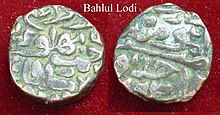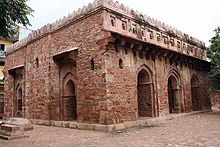Bahlul Khan Lodi: Difference between revisions
m Dating maintenance tags: {{Use Indian English}} |
History Vandalism. All the references mentioned Persian Language. Pushto is deliberately added later. |
||
| Line 24: | Line 24: | ||
}} |
}} |
||
'''Bahlul Khan Lodi''' ([[ |
'''Bahlul Khan Lodi''' ([[Persian language|Persian<ref>http://epicworldhistory.blogspot.de/2012/05/mughal-empire.html : Brief History about Lodis</ref>]]: بهلول لودي ; died July 1489) was the founder of [[Lodi dynasty]] of the [[Delhi Sultanate]] in [[India]] upon the abdication of the last claimant from the previous [[Sayyid]] rule.<ref>History & Civics 9, by Sudeshna Sengupta, p126.</ref>. Bahlul became [[sultan]] of the dynasty on 19 April 1451 (855 [[Hijri year|AH]]). |
||
== Ancestry and early life == |
== Ancestry and early life == |
||
Revision as of 00:15, 4 April 2014
| Bahlul Khan Lodi | |
|---|---|
| Sultan of the Lodi dynasty | |
| Reign | 1451–1489 |
| Coronation | 19 April 1451 |
| Successor | Sikandar Lodi |
| Died | 12 July 1489 |
| House | Lodi dynasty |
Bahlul Khan Lodi (Persian[1]: بهلول لودي ; died July 1489) was the founder of Lodi dynasty of the Delhi Sultanate in India upon the abdication of the last claimant from the previous Sayyid rule.[2]. Bahlul became sultan of the dynasty on 19 April 1451 (855 AH).
Ancestry and early life

Bahlul belonged to the Shahu Khel clan of the Lodi Pashtun tribe. Bahlul's grandfather, Malik Bahram, settled in Multan during the reign of Firuz Shah Tughluq and took service under the governor of Multan, Malik Mardan Daulat. Malik Bahram had a total of about five sons. His eldest son, Malik Sultan Shah Lodi, later served under the Sayyid dynasty ruler Khizr Khan and distinguished himself by killing in the battle later's worst enemy Mallu Iqbal Khan. He was rewarded with the title of Islam Khan and in 1419 appointed the governor of Sirhind. Bahlul, the son of Malik Kala, the younger brother of Malik Sultan was married to Malik Sultan's daughter.
In his youth, he was involved in the trading of horses and once sold his finely bred horses to the Sayyid dyansty Sultan Mohammad Shah. As a payment he was granted a pargana and raised to the status of amir. After the death of Malik Sultan, he became the governor of Sirhind. He was allowed to add Lahore to his charge. Once, Sultan Muhammad Shah asked for his help when the Malwa Sultan Mahmud Shah I invaded his territory. Bahlul joined the imperial army with 20,000 mounted soldiers. By his clevernees, he was able to project himself as a victor over the army of the Malwa Sultan and Sultan Muhammad Shah conferred on him the title of Khan-i-Khanan. He also accepted Bahlul's occupation over a large part of Punjab.
In 1443, Bahlul attacked Delhi but he did not succeed. During the reign of last Sayyid ruler Sultan Alam Shah, Bahlul again made another unsuccessful attempt to capture Delhi in 1447. Finally, when Alam Shah retired to Badaun in 1448, a minister of Alam Shah, Hamid Khan invited him to occupy the throne of Delhi. After the voluntary abdication of the throne by Alam Shah, Bahlul Shah ascended the throne of Delhi on 19 April 1451 and adopted the title of Bahlul Shah Ghazi. Alam Shah continued to live in Badaun till his death in July 1478.[3][4]
The tomb of the founder of the Lodi dynasty lies close to the shrine of the noted Sufi saint, Nasiruddin Chirag-e-Delhi, in a locality that goes by his name, 'Chirag Delhi'.[5][6]
The reign

After ascending to the throne, Bahlul decided to dispose of Hamid Khan. His cousin and brother-in-law Malik Mahmud Khan alias Qutb-ud-din Khan (Governor Of Samana) imprisoned Hamid Khan.[4]
In 1479, Sultan Bahlul Khan Lodi defeated and annexed Sharqi dynasty based at Jaunpur. Bahlul Khan did much to stop rebellions and uprisings in his territories, and extended his holdings over Gwalior, Jaunpur and upper Uttar Pradesh. In 1486, he appointed his son, Babrak Shah as viceroy of Jaunpur. In time, this proved to be problematic, as his second son, Nizam Khan (Sikandar Lodi) was named successor, and a power struggle ensued upon his death in 1489.
Death
Bahlul died in July 1489 after a long reign.[7] His tomb is a drab place compared to other mausoleums. It is a square chamber with three arched openings on all sides, surmounted by five domes, the central one being the biggest. Koranic verses are inscribed on the arches but there is hardly any other ornamentation.
See also
References
- ^ http://epicworldhistory.blogspot.de/2012/05/mughal-empire.html : Brief History about Lodis
- ^ History & Civics 9, by Sudeshna Sengupta, p126.
- ^ Majumdar, R.C. (ed.) (2006). The Delhi Sultanate, Mumbai: Bharatiya Vidya Bhavan, pp.134-36, 139-142
- ^ a b Mahajan, V.D. (1991, reprint 2007). History of Medieval India, New Delhi: S. Chand, ISBN 81-219-0364-5, pp.245-51
- ^ Delhi's Valley of Kings The Tribune, 1 March 2004.
- ^ Bahlul Khan Lodi Tomb - Location Wikimapia.
- ^ Sultan Bahlul Khan Lodi The Muntakhabu-’rūkh by Al-Badāoni (16th century historian), Packard Humanities Institute.
